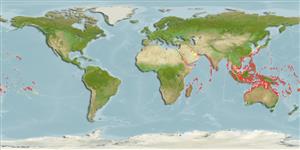分類 / Names
共通名の | 類義語 | Catalog of Fishes(部類, 種) | ITIS | CoL | WoRMS | Cloffa
>
Eupercaria/misc (Various families in series Eupercaria) >
Labridae (Wrasses)
Etymology: Labroides: Greek, labrax, -akos = a fish, Dicentrarchus labrax + Greek, suffix, oides = similar to (Ref. 45335).
More on author: Valenciennes.
Environment: milieu / climate zone / depth range / distribution range
生態学
海 関連する礁; 移住性ではない; 深さの範囲 0 - 100 m (Ref. 128797), usually 1 - 30 m (Ref. 27115). Tropical; 24°C - 28°C (Ref. 27115); 32°N - 36°S, 24°E - 124°W
Indo-Pacific: Persian Gulf (Ref.80050); Red Sea and East Africa (Ref. 4392) to the Line, Marquesas, and Ducie islands, north to southern Japan, south to Lord Howe and Rapa islands.
サイズ / 重さ / 年齢
Maturity: Lm ? range ? - ? cm
Max length : 14.0 cm TL オス/雌雄の選別がない; (Ref. 55367); 最大記録サイズ: 4 年 (Ref. 3426)
背面の脊椎 (合計) : 9; 背鰭 (合計) : 10 - 11; 肛門の骨: 3; 臀鰭: 10. Often with yellow back in deep water (Ref. 48636). Scales on lateral line: 50-52 (+2 past hypural) (Ref. 1602).
Inhabits coral rich areas of inner lagoons and subtidal reef flats to seaward reefs (Ref. 1602). Feeds on crustacean ectoparasites and mucus of other fishes (Ref. 9823, 48636). Monogamous (Ref. 52884). A protogynous hermaphrodite (Ref. 55367). Stays in stations where other fish come to be cleaned. Cleaning intensity is not related to client size or commonness (Ref. 28019). Cleaning stations are occupied by a pair of adults, a group of juveniles or a group of females accompanied by a dominant male where a female becomes a functional male if the dominant male disappears (Ref. 5503). Some adults solitary and territorial. An unfamiliar visitor is usually greeted by dance-like movements with the tail maneuvering the back part of the body up and down. Juveniles behave this way when divers approach closely (Ref. 48636). Minimum depth range of 1 meter in Ref. 27115.
Life cycle and mating behavior
Maturities | 繁殖 | Spawnings | Egg(s) | Fecundities | 幼生
Bi-directional sex change has been confirmed for this species (Ref. 103751). Oviparous, distinct pairing during breeding (Ref. 205). Pelagic spawners. Sex reversal is completed in 14-18 days (Ref. 34185, 34258). A monandric species (Ref. 55367). Length at sex change = 8.8 cm TL (Ref. 55367). Monogamous mating is observed as both facultative and social (Ref. 52884).
Randall, J.E., G.R. Allen and R.C. Steene, 1990. Fishes of the Great Barrier Reef and Coral Sea. University of Hawaii Press, Honolulu, Hawaii. 506 p. (Ref. 2334)
Human uses
水産業: 興味がない; 水族館・水槽: 商業
用具
特記事項
XMLをダウンロードして下さい
インターネットの情報源
Estimates based on models
Preferred temperature (Ref.
123201): 24.6 - 29, mean 27.8 °C (based on 1388 cells).
Phylogenetic diversity index (Ref.
82804): PD
50 = 0.5312 [Uniqueness, from 0.5 = low to 2.0 = high].
Bayesian length-weight: a=0.00589 (0.00332 - 0.01045), b=3.17 (3.01 - 3.33), in cm total length, based on LWR estimates for this species & (Sub)family-body (Ref.
93245).
栄養段階 (Ref.
69278): 3.5 ±0.4 se; based on diet studies.
回復力 (Ref.
120179): 手段, 1.4年~4.4年の倍増期間の最小個体群 (tmax=4).
Fishing Vulnerability (Ref.
59153): Low vulnerability (10 of 100).
Nutrients (Ref.
124155): Calcium = 103 [54, 177] mg/100g; Iron = 0.69 [0.39, 1.37] mg/100g; Protein = 18 [15, 20] %; Omega3 = 0.104 [0.059, 0.182] g/100g; Selenium = 27.8 [13.9, 56.3] μg/100g; VitaminA = 140 [40, 597] μg/100g; Zinc = 1.76 [1.15, 2.82] mg/100g (wet weight);
